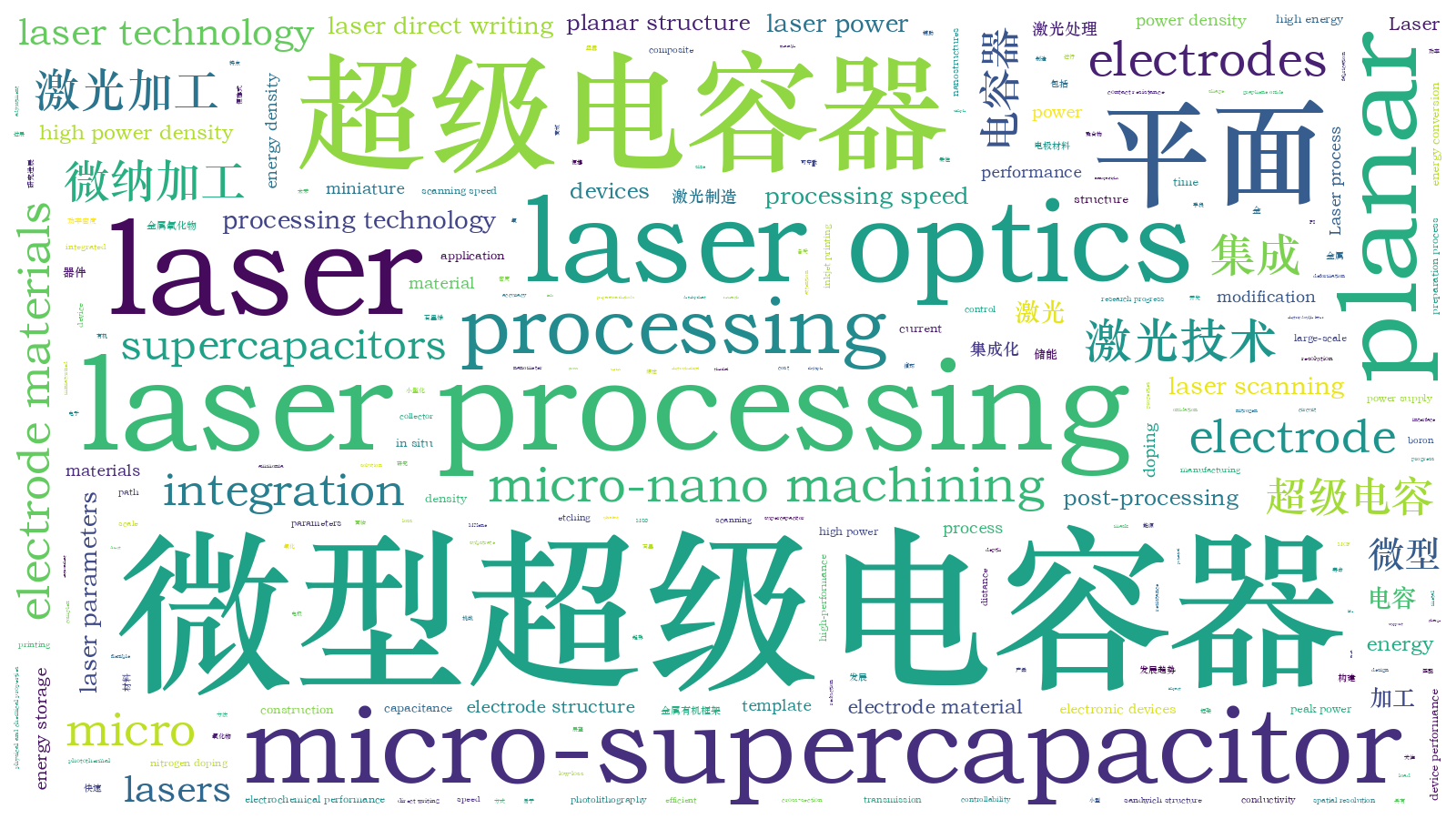基于激光加工的平面型微型超级电容器  下载: 1961次特邀综述
下载: 1961次特邀综述
Significance Emerging portable wearable electronic devices require high-performance and integrable micropower sources. Micro-supercapacitors with high power density, rapid charge and discharge, and long life cycles have received widespread attention. Differing from the traditional sandwich structure, planar micro-supercapacitors do not require separators because their electrodes are on the same plane with certain physical distance, including parallel line, interdigital, and coil types, which significantly reduce the interface contact resistance and improve the electrochemical performance of the device. In addition, the ion transmission path of planar micro-supercapacitors would remain constant as the electrode load increases due to the unique vertical opposite cross-section electrode structure. This could increase energy density without losing power density. The miniaturized planar structure is considered highly compatible with microelectronic systems that can be integrated into other circuits as power supply units to provide effective peak power within a short time.
To date, various planar micro-supercapacitor construction methods have been developed, such as oxidation etching, printing, and photolithography technologies. However, some challenges remain. Oxidation etching technology involves multiple steps and complex operations, which, at minimum, requires a template to construct metal current collectors while removing the excess active material. Low-cost inkjet printing can be used to construct the current collector in a non-contact manner; however, the preparation process of the printable ink is complicated. Although photolithography technology is often used to prepare the planar electrode arrays of micro-supercapacitors, the post-processing procedures are cumbersome, which limits its application in the integrated manufacturing of microdevices. Compared with the above preparation methods, laser processing technology, which does not require a template and features high processing speed and nanometer spatial resolution, is a promising and efficient tool. Specifically, the designated electrode patterns can be precisely constructed using laser processing technologies on demand. For example, ultrafast lasers, which have instantaneous high energy with low thermal impact and negligible working area deformation, can also accurately control and fabricate microelectrodes in a short time. To improve overall performance, the physical and chemical properties, such as modification, doping, and electrode conductivity, can also be controlled in situ and regulated by adjusting laser parameters. Laser process technology has become increasingly important in the development of microdevices. Therefore, there is a great need to summarize the research progress of laser processing for micro-supercapacitors to provide references for the future design and preparation of advanced micro-energy storage devices.
Progress Due to its unique advantages, laser technology is widely used in the physical processing of electrode patterns and the modification of electrode materials for micro-supercapacitors. Laser technology can be employed to realize in situ fabrication or adjustment of micro- and nanostructures in electrodes and composite electrodes with pseudo capacitance and electric double layer capacitance. Thus, laser technology is considered an effective and convenient manufacturing strategy for micro-supercapacitors. More importantly, the capabilities of laser technology to realize the precise size and shape of microelectrodes as well as the possible for large-scale integration of various circuits provide a variety of potential application scenarios for micro-supercapacitors. In the physical construction of patterns, researchers have been able to effectively control the distance between adjacent electrodes by adjusting the processing accuracy of the laser, which can shorten the ion transmission path between two electrodes, thereby improving device performance. For example, adjustable finger-shaped microelectrodes were obtained simultaneously on the upper and lower surfaces of graphene oxide (GO) film, in part, to the flexible controllability of the laser. Surface capacitance could be further improved by connecting devices in series outside the plane. In addition, laser technology has also been used to realize a microelectrode current collector or mask, which usually acts as a substrate or template to realize microelectrodes through simple template imprinting, electrodeposition, and other methods. Laser processing technology has been deployed to facilitate efficient, large-scale production of miniature energy storage devices whereby hundreds of miniature devices can be produced in a short time. The advantages of lasers are also reflected in the fast and effective integration of different circuit components to support low-loss energy conversion.Research on electrode modification revealed that adjusting laser scanning parameters, such as laser power and scanning speed, affected the conductivity of some specific electrodes to a certain extent, such as the use of laser photothermal reduction of GO materials. In addition, doping and modifying nanoparticles or atoms in microelectrodes could also be performed in situ using laser direct writing technology. In this regard, various composite electrodes and heteroatom doped electrodes were obtained by laser processing the raw material containing functional components. For example, boron-doped electrode materials were successfully prepared by laser processing a PI sheet containing boron elements. Moreover, the heteroatom doping process has also been achieved by placing the electrode material in a special environment for laser processing. For example, nitrogen doping of GO material was prepared in the presence of ammonia by irradiating the GO solution with a laser.
Conclusion and Prospect Currently, the primary role of lasers in the construction of miniature supercapacitors is physical marking and electrode modification. Due to their unique advantages, lasers have gradually become a popular tool for preparing micro-supercapacitors. However, this process still requires in-depth and detailed exploration to promote the comprehensive application of this processing technology in miniature energy storage devices.
白聪聪, 张峻豪, 高畅, 靳绪庭, 李欣, 熊伟, 闫剑锋, 张志攀, 赵扬, 曲良体. 基于激光加工的平面型微型超级电容器[J]. 中国激光, 2021, 48(2): 0202013. Congcong Bai, Junhao Zhang, Chang Gao, Xuting Jin, Xin Li, Wei Xiong, Jianfeng Yan, Zhipan Zhang, Yang Zhao, Liangti Qu. Planar Micro-Supercapacitor Based on Laser Processing[J]. Chinese Journal of Lasers, 2021, 48(2): 0202013.







